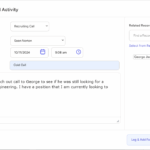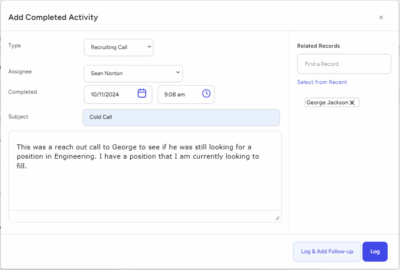Employee engagement has become a top priority for organizations across the globe. Companies that prioritize employee engagement are known to have more productive, motivated, and loyal employees. This has led to an increased interest in employee engagement software, which is designed to help companies keep their employees engaged and satisfied with their work. In this blog post, we’ll discuss the benefits of employee engagement software and how it can help organizations improve their employee engagement.
What is employee engagement software?
But first things first. What is employee engagement software?
Employee engagement software is a tool that companies use to measure, monitor, and enhance the level of engagement among their employees. It is a crucial aspect of organizational success, as it allows organizations to ensure their workforce is motivated, committed, and productive. With the help of employee engagement software, companies can gather data and insights into what drives employee engagement, what areas need improvement, and what initiatives to implement.
Employee engagement software can provide various features, such as pulse surveys, feedback mechanisms, recognition programs, and goal-setting tools. Pulse surveys are short, frequent surveys that assess employee satisfaction and engagement levels. Feedback mechanisms allow employees to provide feedback on their work experiences, which companies can use to identify areas for improvement. Recognition programs incentivize and reward employees for their achievements and contributions. Goal-setting tools enable employees to set and track their progress towards professional development goals.
By using employee engagement software, companies can foster a positive work culture that promotes employee well-being, job satisfaction, and retention. Engaged employees are more likely to be motivated to work, enthusiastic about their roles, and committed to achieving the company’s objectives. They also tend to have higher job satisfaction and a lower likelihood of leaving their current jobs.
The benefits of employee engagement software
Moreover, employee engagement software enables organizations to identify potential issues and take corrective measures to mitigate them. For instance, if employee feedback indicates dissatisfaction with the company’s communication channels, the company can take steps to improve them. Similarly, if an employee feels undervalued, recognition programs can help improve their sense of self-worth.
Below are 10 benefits of employee engagement software:
#1—Measure and track employee engagement.
One of the key benefits of employee engagement software is that it provides a centralized platform for tracking and analyzing employee engagement data. This can help organizations to get a holistic view of their employees’ engagement levels and identify any trends or patterns that may be impacting engagement.
Employee engagement software can also provide valuable insights into individual employee engagement levels, which can help managers to identify at-risk employees and take proactive steps to improve their engagement. For example, managers can use the software to track an employee’s engagement level over time and identify any significant changes or declines.
Another key feature of employee engagement software is that it can provide customized feedback and recommendations based on the organization’s specific engagement data. This can help managers to identify specific areas where improvements can be made and take targeted actions to address them.
Employee engagement software is a powerful tool for organizations looking to improve their employee engagement levels. By providing centralized tracking and analysis, individualized feedback and recommendations, and actionable insights, this software can help organizations to create a more engaged and productive workforce.
#2—Communicate more effectively with employees.
Employee engagement software can help organizations communicate more effectively with their employees in a variety of ways. First, it allows employers to send targeted and personalized messages to their employees. Using the software, managers can send messages to specific groups or individuals based on their role, location, or other criteria. This ensures that employees receive relevant information that is specific to their needs and interests, which can increase their engagement with the organization.
Second, the software can facilitate two-way communication between managers and employees. Employees can provide feedback, ask questions, or raise concerns using the software, and managers can respond promptly. This helps to create a culture of open communication and transparency, which can improve employee engagement and satisfaction.
Third, the software can enable organizations to use different communication channels to reach their employees. For example, some employees may prefer to receive information via email, while others may prefer to access it through an intranet or mobile app. Employee engagement software can support multiple channels, ensuring that all employees can access information in the way that suits them best.
Finally, employee engagement software can provide organizations with real-time data and insights into employee engagement levels. By tracking employee engagement metrics, such as satisfaction levels, turnover rates, and absenteeism rates, organizations can identify areas where they need to improve communication or make changes to improve engagement levels. This can help organizations to take proactive steps to address issues before they become more significant problems.
Employee engagement software can help organizations communicate more effectively with their employees by enabling targeted messaging, two-way communication, multi-channel support, and data-driven insights. By improving communication and engagement levels, organizations can increase employee satisfaction, retention, and productivity.
#3—Recognize and reward employees.
Employee engagement software can help organizations to recognize and reward their employees in multiple ways. The software can help managers to track employee performance and achievements and provide recognition and rewards for these accomplishments.
One way that employee engagement software can help with recognition and rewards is by providing a platform for peer-to-peer recognition. Employees can give each other recognition for their contributions, and this recognition can be seen by managers and other employees. This can help to create a culture of recognition and appreciation within the organization.
Another way that employee engagement software can help with recognition and rewards is by providing a platform for rewards programs. The software can track employee performance and provide rewards for achieving specific goals or milestones. This can include things like bonuses, gift cards, or other incentives.
Employee engagement software can also provide managers with the tools they need to create personalized recognition and rewards programs. Managers can use the software to track employee preferences and interests, and create rewards that are tailored to each employee’s individual needs and interests.
Employee engagement software can help organizations to recognize and reward their employees in a way that is both effective and efficient. By providing a platform for peer-to-peer recognition, rewards programs, and personalized rewards, the software can help to create a culture of appreciation and recognition within the organization. This can lead to increased employee engagement, higher levels of job satisfaction, and improved overall performance.
#4—Provide employees with ongoing training and development opportunities.
By identifying employee interests, skills, and goals, organizations can personalize development plans and offer relevant training programs. This can help employees feel valued and invested in their career growth, which can lead to increased engagement and retention.
Employee engagement software can also help organizations to track employee progress and provide feedback on their performance. This can help employees understand their strengths and areas for improvement, as well as provide guidance on how to reach their career goals. This ongoing feedback and coaching can help to build a culture of continuous learning and development within the organization.
Furthermore, employee engagement software can help organizations identify high-potential employees and provide them with targeted development opportunities. This can help to ensure that the organization has a pipeline of talent for future leadership positions.
In addition, employee engagement software can help to provide employees with access to online training courses, webinars, and other resources that they can use to develop their skills and knowledge. This can be particularly useful for remote or distributed teams who may not have access to in-person training programs.
Investing in employee development through the use of employee engagement software can have a positive impact on employee engagement, retention, and overall organizational success. By providing employees with the tools and resources they need to succeed, organizations can create a culture of learning and growth that benefits both the employee and the organization as a whole.
#5—Create a culture of feedback and continuous improvement.
First, the software can provide a platform for employees to give feedback and suggest ideas anonymously. This allows employees to voice their concerns and opinions without fear of retribution or judgement. Managers can then use this feedback to make improvements to policies, procedures, and culture to better align with employee needs and expectations.
Second, the software can help managers track and respond to employee feedback in a timely manner. This ensures that employees feel heard and valued, and that their feedback is being taken seriously. By addressing concerns and making changes based on employee feedback, managers can improve employee satisfaction and engagement.
Third, employee engagement software can facilitate ongoing performance management and goal-setting. Through regular check-ins and performance reviews, employees can receive feedback on their performance and work towards meaningful goals. This helps to increase motivation, job satisfaction, and overall engagement.
Finally, the software can help organizations promote a culture of continuous learning and development. Through online learning modules and training resources, employees can improve their skills and knowledge. This helps to increase employee satisfaction and engagement, and can also lead to improved performance and productivity.
Employee engagement software can help organizations to create a culture of feedback, continuous improvement, performance management, and learning and development. By facilitating communication, recognition, and ongoing training, the software can help organizations improve employee engagement and ultimately, drive business success.
#6—Improve retention rates.
Employee engagement software can be a powerful tool to help organizations improve their retention rates. By fostering a culture of engagement, organizations can create an environment where employees feel valued, challenged, and supported. This, in turn, can lead to higher levels of job satisfaction and lower turnover rates.
One way employee engagement software can help improve retention rates is by facilitating regular check-ins and feedback sessions between managers and employees. This can provide employees with a sense of autonomy and control over their work, as well as opportunities for growth and development. By giving employees a voice and actively listening to their feedback, organizations can build trust and strengthen their relationships with their employees.
Employee engagement software can also be used to recognize and reward employees for their hard work and achievements. By providing employees with meaningful recognition and rewards, organizations can foster a sense of loyalty and commitment among their workforce. This can help to improve retention rates by making employees feel appreciated and valued.
Another way employee engagement software can improve retention rates is by providing employees with ongoing training and development opportunities. This can help employees to feel challenged and engaged in their work, and can also provide them with the skills and knowledge they need to advance their careers within the organization. By investing in the development of their employees, organizations can create a culture of growth and learning, which can lead to higher levels of engagement and retention.
Employee engagement software can be an effective tool for organizations looking to improve their retention rates. By fostering a culture of engagement, recognition, and development, organizations can create an environment where employees feel valued, challenged, and supported, which can ultimately lead to lower turnover rates and a more committed and engaged workforce.
#7—Improve overall business performance.
One of the primary ways in which employee engagement software improves business performance is by increasing employee productivity. Engaged employees are more likely to be motivated, committed, and focused on achieving the company’s objectives. With the help of employee engagement software, organizations can identify what drives employee engagement, what factors affect employee productivity, and how to improve it. This data can be used to design initiatives that enhance productivity, such as goal-setting tools, recognition programs, and performance feedback mechanisms.
Another way in which employee engagement software improves business performance is by reducing employee turnover. Employee retention is a significant challenge for organizations, particularly in today’s competitive job market. Engaged employees are less likely to leave their current jobs and are more likely to be loyal to the organization. With the help of employee engagement software, companies can identify the drivers of employee turnover, such as job dissatisfaction, lack of recognition, or lack of growth opportunities. By addressing these factors, organizations can increase employee retention rates, reducing the costs associated with recruitment, training, and lost productivity.
Employee engagement software can also improve overall business performance by fostering a positive work culture. A culture that promotes employee well-being, job satisfaction, and growth opportunities is essential in attracting and retaining top talent. With the help of employee engagement software, organizations can identify areas where they can improve their work culture, such as communication, leadership, and employee recognition. By improving their work culture, organizations can create a more engaging and productive environment, which, in turn, can lead to improved business performance.
#8—Enhance the employer brand.
An organization’s employer brand is critical in attracting and retaining top talent. Employer branding refers to an organization’s reputation as an employer, including its culture, values, and employee experiences. Employee engagement software can play a crucial role in improving an organization’s employer brand by creating a positive employee experience, promoting a strong employer brand, and attracting top talent.
Engaged employees are more likely to be satisfied with their work, motivated to perform their job, and committed to the organization. By using employee engagement software, companies can identify factors that drive employee engagement, such as opportunities for growth, recognition, and feedback mechanisms. These insights can help organizations create a more positive employee experience that fosters employee engagement, job satisfaction, and loyalty, ultimately contributing to a strong employer brand.
With the help of employee engagement software, companies can share employee stories, achievements, and company culture on social media, job boards, and other platforms. This promotes a positive employer brand and enhances the organization’s reputation as an employer of choice, attracting top talent to the organization.
Moreover, employee engagement software can also help organizations attract top talent by offering personalized, engaging, and innovative employee experiences. This is particularly important in attracting younger generations of workers, who place a high value on technology-enabled, innovative, and personalized work experiences. By using employee engagement software, organizations can create customized experiences for their employees, such as goal-setting tools, personalized development plans, and recognition programs, ultimately contributing to a strong employer brand.
#9—Improve compliance and regulatory requirements.
Compliance and regulatory requirements can be challenging for organizations, particularly in industries that are heavily regulated. By using employee engagement software, organizations can improve compliance, reduce the risk of non-compliance, and avoid the associated penalties and reputational damage.
One of the primary ways in which employee engagement software can improve compliance is by enhancing communication and training. Compliance requirements are constantly evolving, and it is essential for employees to stay up to date with the latest regulations and standards. Employee engagement software can facilitate communication and training, enabling organizations to provide employees with the information they need to comply with regulatory requirements. This can include online training modules, digital compliance manuals, and communication tools that enable employees to stay informed about the latest regulations.
Employee engagement software can also help organizations track and monitor compliance efforts. By using data analytics tools, organizations can monitor employee compliance with regulatory requirements, identify areas of non-compliance, and take corrective action. This can include targeted training, performance feedback, and other initiatives designed to improve compliance.
Furthermore, employee engagement software can help organizations improve compliance by fostering a culture of compliance. Engaged employees are more likely to understand the importance of compliance, follow rules and regulations, and report non-compliance when they observe it. With the help of this software, organizations can create a culture of compliance by promoting open communication, providing feedback, recognizing and rewarding compliance efforts, and other initiatives.
#10—Reduce costs.
By creating a more engaged and productive workforce, employee engagement software can help organizations improve operational efficiency and reduce turnover, ultimately leading to cost savings.
One of the primary ways in which employee engagement software can help organizations reduce costs is by improving employee retention. Turnover can be expensive for organizations, particularly when it comes to replacing experienced employees or those in leadership positions. Employee engagement software can help organizations identify factors that contribute to employee turnover and take corrective action, such as improving work-life balance, providing opportunities for growth, or enhancing recognition programs.
Engaged employees are more productive, and employee engagement software can help organizations identify and address factors that may be hindering productivity, such as inefficient processes, lack of training, or poor communication. By addressing these issues, organizations can improve operational efficiency, reduce costs, and enhance overall performance.
By creating a more engaged and productive workforce, organizations can reduce the need for frequent recruitment and training, ultimately leading to cost savings. In addition, employee engagement software can help organizations identify and develop internal talent, reducing the need to hire external candidates for leadership positions.
Employee engagement software has become an essential tool for organizations to improve employee engagement and satisfaction. Its benefits include the ability to measure and track employee engagement, communicate more effectively with employees, recognize and reward employees, provide ongoing training and development opportunities, create a culture of feedback and continuous improvement, improve retention rates, improve overall business performance, improve employer brand, improve compliance and regulatory requirements, and reduce costs.
As the importance of employee engagement continues to grow, employee engagement software will become an increasingly important tool for organizations to achieve their business goals!








